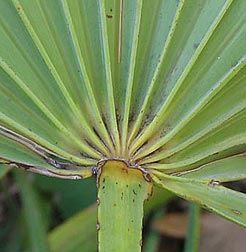homoplasy
A characteristic that is shared within species but not present within their ancestors.
RA
homoplasy
A characteristic that is shared within species but not present within their ancestors.
RA
In their original description Mejía and García (2013) indicated that C. jimenezii is morphologically similar to C. gracilis, but the former has leaves with whitish indumentum on both surfaces and a blade that is not fully circular in outline, and with a truncate hastula that is only a little visible on the underside; leaf sheaths thin and soft-textured; and fruits yellowish white at maturity.
What can you infer about the physiology based off of the morphology of the plant?
RA
degree of genetic differentiation between these populations, and (3)
What may be some causes for genetic differentiation within these two populations?
RA
hermaphroditic flowers
A flower that contains sex organs of both the male and female. These organs are known as the carpellate (produces ovules) for females and staminate (produces pollen) for males.
herbarium specimens
A collection of preserved plant specimen used for specific scientific study. 
RA
The high levels of genetic differentiation detected within C. jimenezii raise questions whether these two populations can be treated as different varieties/subspecies within this taxon or if indeed they may represent two different species.
In this study, the researchers found some questions as to whether the two species of C. jimenezii could be grouped with the same taxa.
Upon meeting with the author, it was stated that the molecular tools used, found a large amount of differentiation. This was not what the authors hoped and in turn was concluded that they were to remain in separate taxa.
RA
Therefore we recommend not translocating material between these two populations for genetic conservation or ecological restoration programs until the taxonomy of this species within Coccothrinax is further studied.
Genetic conservation of this population is important due to the few individuals left in Haiti and the Dominican Republic.
Upon meeting with the author, the difficulty of finding the purebred species was discussed as were the methods.
RA
The taxonomic uncertainties between the two populations of C. jimenezii have important implications for reintroduction programs. These two sites of C. jimenezii represent two clear management units for conservation, and the population genetic data suggest that we cannot rule out that they are two distinct taxa.
The authors concluded based off of the molecular data, that the two species of C. jimenezii could not be identified as two different taxa.
RA
hastula
The junction between the leaf and the stem blade. 
RA
taxon
Is a unit of biological classifications of an organism. This can be a group of rank such as, species, family or class.
RA
We have not been able to find data regarding the environmental history in these two populations since the 15th century. However, there is agreement among conservation biologists that since the arrival of the Europeans to this island there has been habitat fragmentation and deforestation linked to rapid expansion of urban and rural activities (Sambrook et al., 1999; Alscher, 2011; Foxx, 2012). Palms have long-life cycles; therefore, the detrimental consequences of genetic drift on genetic diversity can take a long period of time to manifest because of their long generation time and the presence of overlapping cohorts (Duminil et al., 2009).
Since the extinction of C. jimenezii is of primary concern, the authors grab resources from other works to help solidify this concept. It is clear that the conservation of this species is vital to this study.
RA
anthropogenic
The influence of humans in the modification of nature.
RA
habitat fragmentation
The division of large habitats into smaller patches, resulting in discontinuities within the organisms preferred habitat.
This phenomena results in the degradation of an ecosystem.
RA
genetic variation
Genetic variation is the differences in the genetic makeup within populations over time.
RA
fructifications
In angiosperms, when a plant bares fruit.
RA
inflorescences
In a flowering plant, it is a cluster of flowers either on a main branch or system of branches.
RA
ethnobotanical
The study of how humans within a cultures use plants as folk remedy.
RA